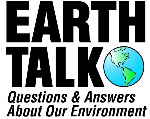ARE THERE PESTICIDES IN MY FOOD?Dear EarthTalk: How do I learn about what pesticides may be on the food I eat?
-- Beatrice Olson, Cleveland, OH
Along with the rise in the popularity of organic food has come an increased awareness about the dangers lurking on so-called “conventionally produced” (that is, with chemical pesticides and fertilizers) foods.
“There is a growing consensus in the scientific community that small doses of pesticides and other chemicals can have adverse effects on health, especially during vulnerable periods such as fetal development and childhood,” reports author and physician Andrew Weil, a leading voice for so-called integrative medicine combining conventional and alternative medical practices. He adds that keeping one’s family healthy isn’t the only reason to avoid foods produced using chemical inputs: “Pesticide and herbicide use contaminates groundwater, ruins soil structures and promotes erosion, and may be a contributor to ‘colony collapse disorder’, the sudden and mysterious die-off of pollinating honeybees that threatens the American food supply.”
In general, fruits and vegetables with an outer layer of skin or rind that can be peeled and discarded are the safest in terms of pesticide residues. Most pesticides are sprayed on the outside of produce. So if you are going to toss the rind of that cantaloupe, you might as well save money and buy a conventional version. But a red pepper would be a different story: For those items consider it money well spent to go organic. The non-profit Environmental Working Group (EWG) lists a “dirty dozen” of fruits and vegetables with the highest pesticide load so that consumers know to look for organic varieties of them when possible. The dirty dozen are: apples, celery, strawberries, peaches, spinach, nectarines, grapes, sweet bell peppers, potatoes, blueberries, lettuce and kale/collard greens.
Another non-profit working hard to raise awareness about pesticide residues on foods is the Pesticide Action Network (PAN). The group’s recently launched website and accompanying iPhone app called “What’s On My Food” helps consumers know specifically which pesticide residues are likely ending up on their foods (and in their bloodstreams). In creating the database, PAN linked pesticide food residue data with the toxicology for each chemical and made the combined information easily searchable. “Pesticides are a public health problem requiring public engagement to solve,” the group reports, adding that “What’s On My Food” can be an important tool in raising awareness.
While the website version of “What’s On My Food” is helpful for advance planning, the iPhone app is handy while plying the supermarket produce aisles to help decide whether to go for organic vegetables or stick with the cheaper conventional ones. For instance, the database shows that conventionally grown collard greens likely contains residues of some 46 different chemicals including nine known/probable carcinogens, 25 suspected hormone disruptors, 10 neurotoxins and eight developmental/reproductive toxins—not to mention 25 different compounds known to be harmful to honeybees. Spending a little quality time on the website or app is enough to drive anyone to more organic food purchasing.
CONTACTS: Andrew Weil, www.drweil.com; PAN, https://www.panna.org/resources/do-you-know-whats-in-your-food/ ; EWG, www.ewg.org. 
June 2, 2012
EarthTalk® is written and edited by Roddy Scheer and Doug Moss and is a registered trademark of E - The Environmental Magazine (www.emagazine.com). Send questions to: earthtalk@emagazine.com . | 